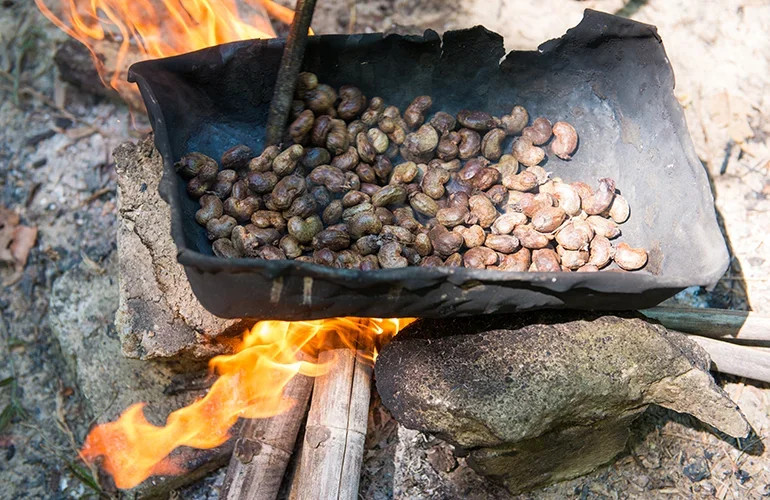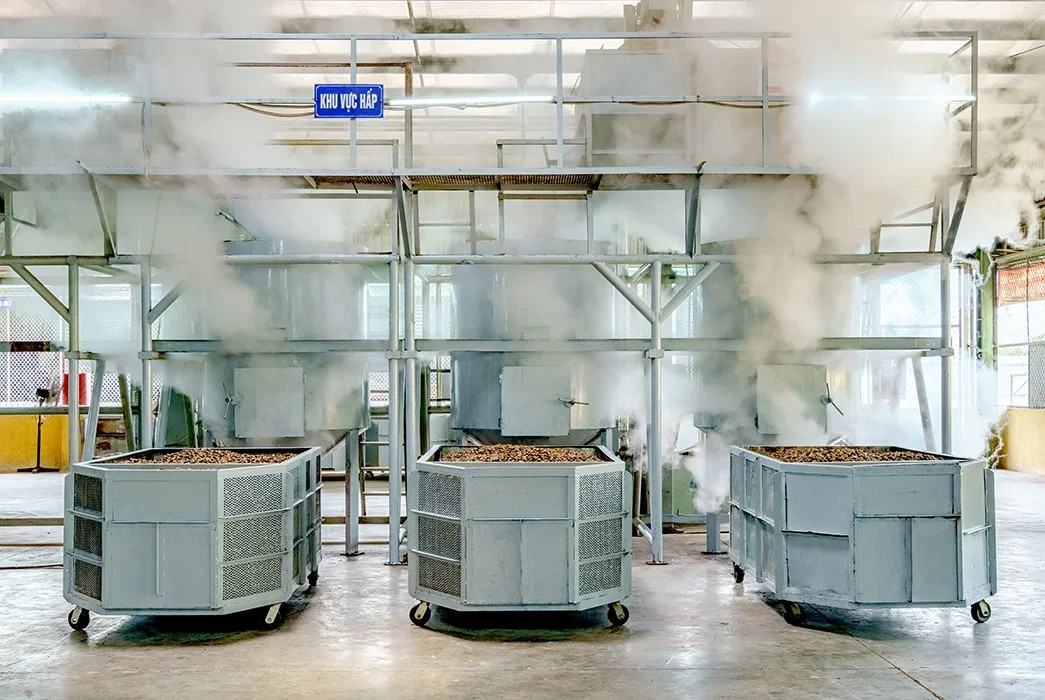Often enjoyed as a snack, ingredient in recipes, or even as cashew butter, cashew nuts are a popular food around the globe. But have you ever stopped to wonder, “Where Do Cashew Nuts Come From?” Many might be surprised to learn that the journey of this kidney-shaped nut, from its origin to our plates, is quite fascinating and deeply rooted in globalization. Let’s delve into the interesting world of cashews and discover their true origins and global path.
Contrary to what the name suggests, cashew nuts aren’t actually nuts in the botanical sense. They are seeds that grow on trees that also produce a rather peculiar fruit.
The Cashew Tree and Its Unusual Fruit
Cashew nuts are the seeds of the cashew tree (Anacardium occidentale), a tropical evergreen native to Brazil. What’s particularly interesting is how the cashew nut is presented. It appears to grow outside of what looks like a fruit, often referred to as the ‘cashew apple’. However, the cashew apple is a ‘false fruit’. Botanically speaking, it’s the swollen stem or peduncle of the cashew flower. The real fruit, a kidney-shaped drupe, grows at the end of this cashew apple. This drupe is what holds the single seed we know as the cashew nut.
From Brazil to the World: The History of Cashew Nuts
Originally native to northeastern Brazil, the cashew tree’s journey to global prominence began in the 16th century. Portuguese explorers, sailing from Brazil, introduced the cashew tree to India. They initially planted it in Goa, primarily to combat soil erosion. The cashew tree, with its extensive root system, proved effective in holding the soil together, and its broad canopy offered protection from heavy rains.
From Goa, the cashew tree gradually spread across the coastal regions of India. Interestingly, elephants played a significant role in propagating cashew trees across the Indian peninsula. After consuming cashew apples and nuts, they dispersed the seeds through their droppings, aiding the natural spread of cashew trees across states like Maharashtra, Goa, and Kerala.
Initially, the cashew was valued more for its soil-binding properties than its nut. It wasn’t until about 400 years after its introduction to India that the commercial potential of cashew nuts was truly realized.
The Global Cashew Industry: India vs. Vietnam
The cashew nut has since become a major player in global commodity markets, evolving into a multi-billion dollar industry. For a long time, India was the dominant force in cashew production and export. However, in recent years, Vietnam has emerged as the world’s leading cashew nut supplier, surpassing India.
While India remains a significant exporter, supplying cashews to over 60 countries and being among the top agricultural exports, Vietnam’s rise to the top is a remarkable story of industrial transformation. One key factor in Vietnam’s success is its embrace of mechanization in cashew processing.
 Cashew nut harvesting in a village in India, highlighting the traditional methods used in some regions.
Cashew nut harvesting in a village in India, highlighting the traditional methods used in some regions.
Cashew Processing: A Labor-Intensive Journey
Traditionally, cashew processing is a labor-intensive process, especially in India where manual methods have been favored to maintain the quality of whole nuts. The process involves several stages: harvesting, roasting, cooling, shelling, peeling, drying, and sorting. A significant reason for the high cost of cashews is the extensive manual labor involved and the fact that each cashew apple yields only one nut.
One of the most challenging and hazardous steps is shelling. The cashew shell contains a corrosive oil called CNSL (cashew nut shell liquid), which can cause severe burns. Despite the risks, a large workforce, predominantly women, is employed in manual cashew processing in some regions, often for low wages.
 Manual cashew roasting, showcasing a traditional step in cashew processing that is still practiced in some areas.
Manual cashew roasting, showcasing a traditional step in cashew processing that is still practiced in some areas.
Mechanization and Vietnam’s Advantage
While machines for shelling cashews have been around since the 1960s, their adoption was initially slow due to issues with kernel breakage and CNSL contamination. However, Vietnam invested heavily in developing and implementing advanced mechanical processing technologies.
Modern cashew processing plants in Vietnam utilize high-tech machinery that significantly increases efficiency and reduces the need for manual labor. A smaller workforce in these mechanized plants can process much larger volumes of cashews compared to traditional manual processing. This efficiency allows Vietnam to reduce labor costs and offer more competitive prices in the global market, contributing to its leading position as a cashew exporter.
 Cashew nut processing factory in Long An, Vietnam, demonstrating the modern, mechanized approach to cashew processing.
Cashew nut processing factory in Long An, Vietnam, demonstrating the modern, mechanized approach to cashew processing.
The Future of Cashew Production
The global cashew industry is at a crossroads. While manual processing sustains livelihoods in some regions, mechanization offers greater efficiency and competitiveness. India, despite being a major cashew producer, faces challenges in adopting mechanization due to economic and social factors. There are concerns about job losses in communities that depend on manual cashew processing.
However, to remain competitive in the global market and meet growing demand, embracing modern technologies in cashew processing seems inevitable. The future of “where cashew nuts come from” will likely see a continued shift towards regions with efficient, mechanized processing capabilities, even as the cashew tree itself maintains its widespread cultivation across tropical landscapes.
In conclusion, the cashew nut’s journey is a global one, originating in Brazil, flourishing in India, and now with Vietnam leading the charge in global supply. Understanding where cashew nuts come from reveals not just their botanical origins but also a fascinating story of globalization, trade, and evolving agricultural practices.
References:
[1] https://www.foodunfolded.com/admin.php?/cp/publish/edit/entry/2693&filter_by_keyword=cashew&search_in=titles_and_content&perpage=25&sort_col=column_entry_date&sort_dir=desc#ref1
[2] https://www.foodunfolded.com/admin.php?/cp/publish/edit/entry/2693&filter_by_keyword=cashew&search_in=titles_and_content&perpage=25&sort_col=column_entry_date&sort_dir=desc#ref2
[3] https://www.foodunfolded.com/admin.php?/cp/publish/edit/entry/2693&filter_by_keyword=cashew&search_in=titles_and_content&perpage=25&sort_col=column_entry_date&sort_dir=desc#ref3
[4] https://www.foodunfolded.com/admin.php?/cp/publish/edit/entry/2693&filter_by_keyword=cashew&search_in=titles_and_content&perpage=25&sort_col=column_entry_date&sort_dir=desc#ref4
[5] https://www.foodunfolded.com/admin.php?/cp/publish/edit/entry/2693&filter_by_keyword=cashew&search_in=titles_and_content&perpage=25&sort_col=column_entry_date&sort_dir=desc#ref5
[6] https://www.foodunfolded.com/admin.php?/cp/publish/edit/entry/2693&filter_by_keyword=cashew&search_in=titles_and_content&perpage=25&sort_col=column_entry_date&sort_dir=desc#ref6
[7] https://www.foodunfolded.com/admin.php?/cp/publish/edit/entry/2693&filter_by_keyword=cashew&search_in=titles_and_content&perpage=25&sort_col=column_entry_date&sort_dir=desc#ref7
[8] https://www.foodunfolded.com/admin.php?/cp/publish/edit/entry/2693&filter_by_keyword=cashew&search_in=titles_and_content&perpage=25&sort_col=column_entry_date&sort_dir=desc#ref8
[9] https://www.foodunfolded.com/admin.php?/cp/publish/edit/entry/2693&filter_by_keyword=cashew&search_in=titles_and_content&perpage=25&sort_col=column_entry_date&sort_dir=desc#ref9
[10] https://www.foodunfolded.com/admin.php?/cp/publish/edit/entry/2693&filter_by_keyword=cashew&search_in=titles_and_content&perpage=25&sort_col=column_entry_date&sort_dir=desc#ref10
[11] https://www.foodunfolded.com/admin.php?/cp/publish/edit/entry/2693&filter_by_keyword=cashew&search_in=titles_and_content&perpage=25&sort_col=column_entry_date&sort_dir=desc#ref11
